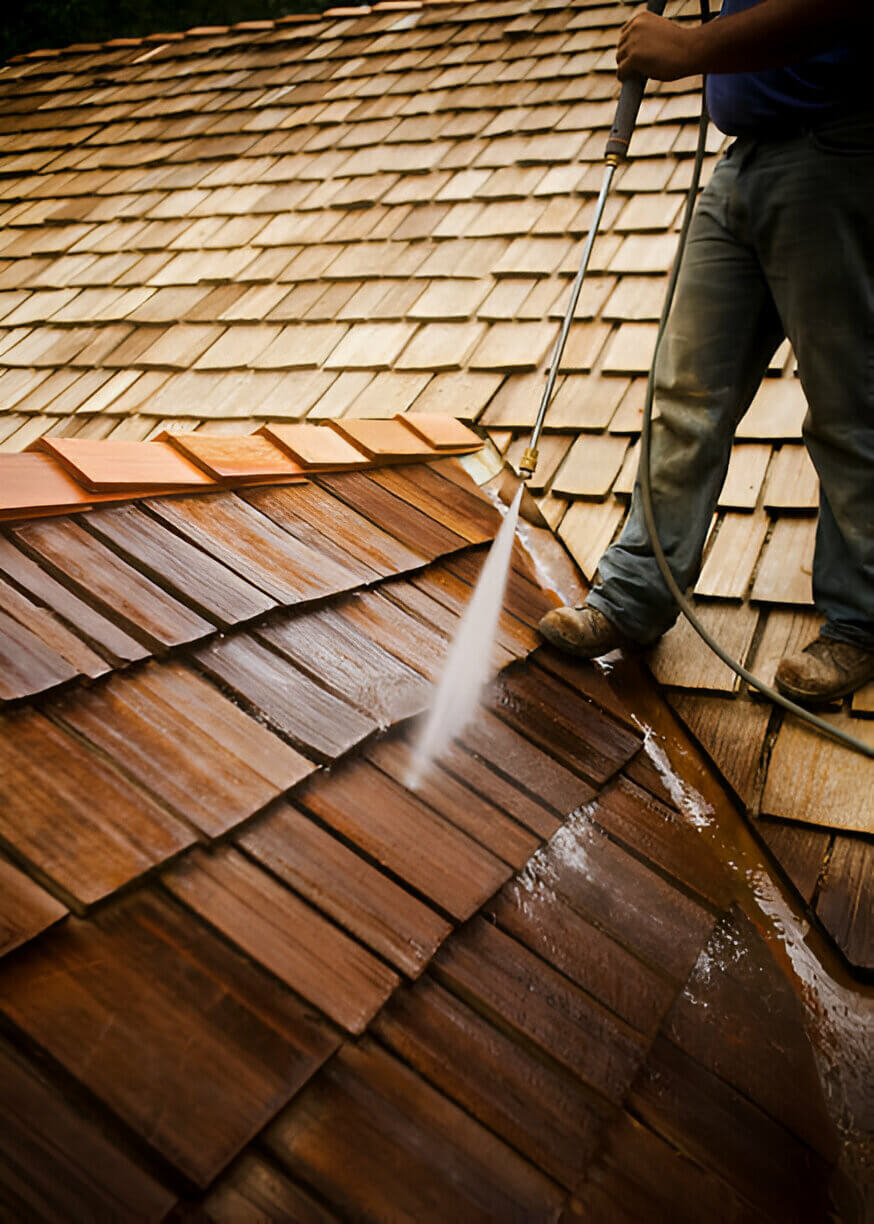Roof maintenance is crucial for the longevity and aesthetics of your home. While pressure washing might seem like a quick and effective way to clean your roof shingles, it is essential to understand the potential risks and best practices associated with this method.
This guide explores whether you should pressure wash your roof shingles and the alternatives available for maintaining a clean roof.

Understanding Roof Shingles
Types of Roof Shingles
There are various types of roof shingles, including asphalt, metal, clay, and wood. Each type has different characteristics and maintenance needs:
- Asphalt Shingles: The most common type, known for their durability and cost-effectiveness.
- Metal Shingles: Long-lasting and resistant to extreme weather.
- Clay Shingles: Often used in warmer climates, these are durable but fragile.
- Wood Shingles: Provide a natural look but require more maintenance.
Understanding the specific type of shingles on your roof is the first step in determining the best cleaning method. Each material reacts differently to pressure washing and other cleaning techniques.
Risks of Pressure Washing Roof Shingles
Damage to Shingles
Pressure washing can be too harsh for most types of shingles. The high-pressure water stream can strip away the protective granules on asphalt shingles, leading to premature wear and tear. For clay and wood shingles, the pressure can cause cracks and splintering. Moreover, water can seep underneath the shingles, damaging the roof deck and potentially leading to leaks.
Asphalt shingles are particularly vulnerable because the granules on the surface, which protect against UV rays and weather, can be dislodged. This degradation reduces the lifespan of the shingles and can lead to costly repairs.
Safety Concerns
Climbing on a roof with a pressure washer is inherently dangerous. The combination of height, water, and slippery surfaces increases the risk of falls and injuries. Additionally, handling a pressure washer on a ladder or roof can be challenging, especially for those without experience.
The risk of accidents is significant, and improper use of pressure washers can lead to severe injuries. It’s crucial to assess whether the cleaning task is within your capability or if professional help is warranted.
Alternatives to Pressure Washing Shingles
Soft Washing
Soft washing involves using a low-pressure spray to apply a cleaning solution to the shingles, which is then rinsed off with a gentle stream of water. This method is less likely to damage the shingles and is effective in removing dirt, grime, and moss. Soft washing is particularly suitable for asphalt shingles and other delicate roofing materials.
Soft washing uses specialized cleaning solutions that break down biological materials like moss and algae without the need for high pressure. This method ensures the integrity of the shingles is maintained while effectively cleaning the roof.
Chemical Cleaning
Another alternative is chemical cleaning, which involves applying a cleaning solution to the shingles and allowing it to sit before rinsing it off. This method is effective for removing tough stains and moss but requires careful handling of chemicals to avoid environmental harm.
Choose environmentally friendly cleaning solutions to minimize the impact on your garden and local wildlife.
Chemical cleaning solutions are formulated to target specific types of stains and growths. When used correctly, they provide a deep clean without the abrasive force of pressure washing.
Manual Cleaning
For smaller areas or less severe dirt buildup, manual cleaning with a garden hose and a soft-bristled brush can be effective. This method is gentle on the shingles and allows for more control over the cleaning process. It’s a labor-intensive approach but ensures that you can clean specific areas without the risk of high-pressure damage.
Manual cleaning is time-consuming but provides a thorough clean for small or detailed areas. It’s also the safest method in terms of preventing damage to the shingles and roof structure.
When Pressure Washing Might Be Necessary
Stubborn Stains and Dirt
In some cases, pressure washing might be necessary to remove stubborn stains or dirt that other methods cannot handle. If you decide to use a pressure washer, set it to the lowest pressure setting and keep the nozzle at least 12 inches away from the shingles. Use a wide-angle spray tip to distribute the pressure evenly and minimize the risk of damage.
For extremely tough stains, such as those caused by pollutants or deep-set mold, a cautious approach to pressure washing might be justified. However, this should always be a last resort and performed with utmost care.
Durable Roofing Materials
Certain durable roofing materials, such as metal or concrete tiles, can withstand pressure washing better than asphalt or clay shingles. Even so, it’s crucial to use the appropriate pressure settings and techniques to avoid potential damage.
Metal roofs, for example, are generally more resilient and can handle the force of pressure washing better than more delicate materials. Still, it’s important to follow recommended practices to prevent scratching or denting the surface.
Best Practices for Roof Cleaning
Preparing for Cleaning
Before cleaning your roof, clear the area around your home to protect plants and outdoor furniture from debris and cleaning agents. Ensure that your gutters and downspouts are clear to allow for proper drainage during the cleaning process.
Preparation is key to a successful cleaning job. Taking the time to set up properly can prevent damage to your home and landscaping.
Safety Measures
Always prioritize safety when cleaning your roof. Wear slip-resistant shoes, a safety harness, and protective goggles. If you’re not comfortable working at heights or handling a pressure washer, consider hiring a professional.
Safety gear and precautions can prevent accidents and injuries. It’s better to invest in safety measures than to risk a serious fall or injury.
Using the Right Cleaning Solutions
Choose cleaning solutions specifically designed for roofs. Follow the manufacturer’s instructions for mixing and application to avoid damaging the shingles. Test the solution on a small, inconspicuous area first to ensure it does not discolor or damage the shingles.
Using the correct products ensures effective cleaning while preserving the integrity of the roofing materials. Avoid using household cleaners not designed for roof use, as they can cause damage or be ineffective.
Conclusion
While pressure washing might seem like a quick solution for cleaning roof shingles, it often does more harm than good. The risks of damaging the shingles and compromising your roof’s integrity outweigh the benefits. Alternative methods like soft washing, chemical cleaning, and manual cleaning are safer and more effective for maintaining a clean and healthy roof.
If you must use a pressure washer, take extreme caution and follow best practices to minimize damage. For many homeowners, hiring a professional roof cleaning service is the best way to ensure a thorough and safe cleaning process.




